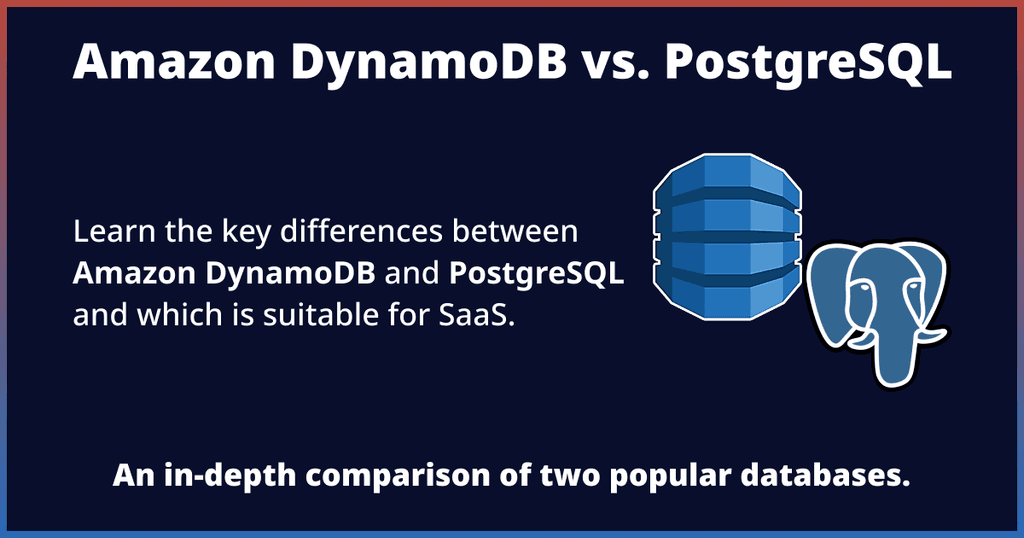A Software-as-a-Service (SaaS) business's success largely depends on proper data management and efficient data retrieval. And no SaaS enterprise can survive in the modern hyper-competitive market without the right database technology.
Therefore, picking a suitable database that aligns with your SaaS application's long-term goals can protect you from future failure. Today, we've hundreds of database technologies to choose from, and it's impossible to study each to make the right choice.
Luckily, the NoSQL Amazon DynamoDB and the open-source PostgreSQL stand out in their respective categories. Both are production-ready database technologies with unique strengths and weaknesses. The real challenge is assessing which best fits your specific use case.
So, in this guide, we'll compare Amazon DynamoDB and PostgreSQL in five key dimensions to explore their operational differences in 2024.
Let's dive straight in.

What Is AWS DynamoDB
AWS DynamoDB is a NoSQL document database offered by the Amazon Web Services (AWS) platform. DynamoDB is a fully managed proprietary database, and AWS is responsible for its maintenance, hardware provisioning, cluster scaling, replication, and backups.
Its unique selling point is the unparalleled speed of data transactions compared to other NoSQL databases like MongoDB. Applications use DynamoDB to handle high-scale mission-critical workloads with millions of requests per second at single-digit millisecond latency.
What Is PostgreSQL
PostgreSQL — commonly known as Postgres — is a robust and battle-tested relational database management system (RDBMS) or RDS. It boasts complete transactional integrity and efficient handling of data-heavy workloads with complex relationships and querying logic.
PostgreSQL is also ACID (Atomicity, Consistency, Isolation, Durability) compliant and supports most SQL standards natively. Its greatest strength is ensuring data consistency, integrity, and concurrency over large datasets across multiple tables.
Comparison: DynamoDB vs Postgres
We'll now compare DynamoDB and PostgreSQL via the alternating method (point-by-point approach). This comparison should help you better understand the strengths and weaknesses of each database technology.
Data Querying
DynamoDB offers point lookups via its key-value and document data models. The queries use unique primary keys to access each item in a table, and the database doesn't constrain other non-primary key attributes by a schema. This capability enables you to store structured and semi-structured data like JSON documents. Additionally, DynamoDB offers secondary indexes to specify alternate key structures. You can use them to access records with the same secondary index or query data with a different sorting order of attributes.
PostgreSQL offers a powerful SQL-based querying language to implement complex queries with many filter, join, and data aggregation statements and seamlessly integrates with major programming languages. It delivers unmatched data retrieval capabilities and a rich feature set, including table inheritance, nested transactions, asynchronous replication, and full-text search. Also, unlike DynamoDB, PostgreSQL can run NoSQL workloads to store and query unstructured or frequently changing data in a table not constrained by the main schema.
Performance
AWS markets its DynamoDB as a high-performance NoSQL database. It scales horizontally to support tables of virtually any size and handles millions of read/write requests at extremely low latencies. DynamoDB provides incredible I/O performance via SSDs to store and query petabytes of static or rapidly changing data for real-time applications. Additionally, you can toggle the database's in-memory cache, called the DynamoDB Accelerator (DAX), and enjoy up to 10 times better table performance.
PostgreSQL can efficiently query large datasets across multiple tables with complicated relationships, attribute sorting, and filtering logic. It supports horizontal and vertical scaling but fails to match DynamoDB's performance under read-heavy or high-traffic scenarios. But you can use an SSD with an ultra-fast in-memory database like Redis to cache queries and significantly reduce response times. Also, PostgreSQL performs well if you stick to best practices for database schema design and write well-optimized queries for read and write operations.
Data Integrity
DynamoDB offers conditional checks as an extra safety net for write operations to prevent accidental or invalid overwrites to the database. It also guarantees ACID-compliant data integrity for all primary-key-based queries but not for complex relational queries. Thus, for complicated data operations, DynamoDB sacrifices immediate data consistency for high availability and speed. This approach ensures that the database eventually reflects the data across the entire cluster without losing performance.
PostgreSQL's ACID transactions force all related database operations to either fully succeed or fail to ensure strict data consistency throughout the database. PostgreSQL also uses foreign-key constraints to maintain referential integrity and consistency in tables with complex relationships. Different data constraints, like UNIQUE, NOT-NULL, PRIMARY-KEY, and CHECK, prevent invalid write operations and duplicate data, and unique table indexes ensure data integrity in columns since two rows can't have the same index.
Security
AWS is responsible for the security of every DynamoDB instance since it's a fully managed proprietary software. AWS encrypts all sensitive data via keys stored in the AWS Key Management System (AWS KMS) to prevent unauthorized access. Row-Level Security (RLS), AWS Cognito integration, and Identity & Access Management (IAM) policies enable strict enforcement of granular access rules for each table. The optional Virtual Private Cloud (VPC) further enhances security by isolating the database from other networks like the public internet.
Managed PostgreSQL hosting usually provides basic security for every PostgreSQL cluster, such as regular patches and Secure Sockets Layer (SSL) setups. However, a number of proactive security measures can help completely shield your database from unauthorized intrusions. These include disabling remote access, setting up a trusted hosts list, and fine-tuning permission for every user role. Furthermore, you can configure Row-Level Security (RLS) via PostgreSQL policies to enforce granular data access permissions for each table.
Pricing Model
DynamoDB offers two types of pricing models: provisioned capacity and on-demand. The former supports auto-scaling during traffic spikes and bills you for the number of Read Request Units (RRU) and Write Request Units (WRU) consumed. While the latter charges for the Read Capacity Units (RCU) and Write Capacity Units (WCU) provisioned per hour to ensure that you pay only for what you use. Moreover, costs vary with the regions where your DynamoDB instance lives. For example, N. Virginia or Ohio costs way less than Cape Town or São Paulo.
You either self-host a PostgreSQL database on a VPC or purchase managed hosting. In both cases, you only pay for the resources (i.e., CPU, RAM, network bandwidth, and storage) your database instance consumes. Managed PostgreSQL hosting handles auto-scaling for a monthly fee and prevents your database from failing under high-traffic workloads. You can also manually buy more resources for a server or cluster many servers (shards) together for dynamic scalability. This makes PostgreSQL's pricing much more predictable compared to DynamoDB.
Suitable Use Cases
DynamoDB
DynamoDB can store large amounts of unstructured data and stream it incredibly efficiently. This makes it a viable option for applications with rapidly changing and unpredictable data storage needs.
Here are some examples of suitable application types for DynamoDB:
- Multiplayer games
- High-scale web & mobile apps
- Internet of Things (IoT) platforms
- Real-time analytics
- Recommendation engines
- Data lakes
PostgreSQL
Since PostgreSQL is a relational database, it guarantees strict data consistency and relational integrity across all the tables. It best suits applications that store and query large structured datasets with complex relationships.
Here are some examples of applications best suited for PostgreSQL:
- Customer Relationship Management (CRM) systems
- Electronic Health Record (EHR) systems
- E-commerce web apps
- FinTech apps
- Geospatial apps
- Scientific research & experimentation apps
Conclusion
Choosing a database system for your SaaS business is one of the most crucial decisions you make while planning the app. And even with the necessary knowledge about several database systems, it's not easy to settle for one.
An app's database is not easily replaceable in development, let alone in a production environment. So be sure to create a Minimum Viable Product (MVP) and test it with various databases. This way, you minimize the risk of vendor lock-in with an unsuitable technology.
And that's it for PostgreSQL vs Amazon DynamoDB in 2024. I hope you got the answers you were after, and good luck on your SaaS journey.
But before you leave, a common yet easily fixed security vulnerability allows attackers to inject malicious code into your website and threaten your users' privacy. So, check out why the rel="noopener noreferrer" anchor attribute is crucial for a website's security to protect your business.

